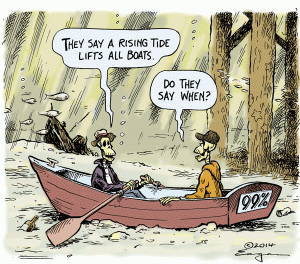Central banks around the world have been consistent in their policy response to the 2008 financial crisis; aggressive quantitative easing and zero interest rate policies have formed the backbone of policy responses for nearly a decade. The initial effectiveness of these policies was a huge feather in the cap of these central banks, most notably the Fed who managed to avert one of the biggest financial catastrophes of the modern era. Now into the seventh year post-lehman however, it is becoming less clear what exit strategy is in place for the numerous QE programs in place throughout the world, and what consequences these policies will have for the global economy in the long run.
Since the Fed tapered its bond purchases in October 2014, other central banks have stepped in aggressively to pick up the slack. Japan has been printing an unrivaled amount of money as part of Shinzo Abe’s stimulus package for the Japanese economy, and the ECB has been on the QE trail since January, promising to buy up to 1.1 trillion euros up until September 2016.
The ECB kickstarted its bond purchase program due to the threat of deflation taking root across the Eurozone much like the Fed’s initial fear of a deflationary spiral emerging in the aftermath of the credit crisis. With deflation now at the forefront of most investors minds given the falling oil price and subdued CPI over the past few months, it seems increasingly likely that these stimulus programs will be in place for the foreseeable future. In the long run however, what are the unintended consequences of these QE programs from the world’s central banks?
Fundamentals are becoming increasingly irrelevant: A rising tide lifts all boats
One of the most dangerous side effects of QE is the impact it has had on investment analysis. Monetary policy, above all else, has become the primary driving force behind markets globally. Fundamental analysis has become, by and large, irrelevant in the face of an ever expanding amount of liquidity chasing a finite amount of assets. Earnings reports are still dissected and talked about in depth, but increasingly these traditional forms of analysis are becoming less and less relevant.

Market valuations across the globe are stretched, bond valuations are at multi century highs, and high end real estate has been bid up to unbelievable levels. The exuberant valuations are overlooked in the belief that a steady flow of liquidity will continue to boost prices going forward.
Savers have been crushed during this whole process
The effect QE has had on interest rates globally has led to a very rough road for savers during this period. Returns have been cut to almost nothing, and in more recent years, the threat of negative interest rates and deposit taxes in certain parts of the world have added to the malaise confronting savers. In the long run, this will turn out to be one of the biggest failures of QE. For new entrants into the labor market since 2007 there has been very little yield available from conventional saving accounts. As a consequence, an entire new investment paradigm is starting to take root, formed primarily on more speculative and riskier investment principles. Savings and capital formation are an essential component of any well functioning economy. Destroying the incentive for people to save is perhaps the biggest regret we will have about QE when the pigeons eventually come home to roost.
Global Missallocation of Capital
Interest rates within the United States have always acted as the bellwether for risk on a global scale. The yield on 10 year treasury bonds has always been the traditional “risk free” rate of return. With US interest rates at near zero, evaluating risk has become an increasingly difficult result. As a result, risk premiums have been contracting around the world and yield starved capital has been flowing into markets and countries which historically would have been avoided. Emerging Markets have seen an unprecedented increase in capital flows which has resulted in some spectacular misallocation of capital within both commercial real estate, residential real estate and financial markets within these countries. We are starting to see some of these investment excesses start to unwind – and these markets look ripe for sustained weakness should interest rates begin to normalize in the near future.
What happens next?
The exit strategy for many of the various QE programs remains a great uncertainty. The Fed has officially tapered its bond purchase program since October 2014 but has held rates at near zero ever since. The challenge facing policy makers going forward is how to unwind the ultra stimulative policies of the last decade without causing a full fledged market crash.
For now, the proceeds of these policies have been pretty well confined in financial assets, creating a two speed economic system where inflation and growth appear to be occurring at a different paces within the real economy and the financial world. There really is no way of knowing what will result as a consequence of pulling QE from under the feet of the financial system. If some of the excess of the financial system starts to manifest itself within the CPI, then there is no way of telling where this will end. 2015 is shaping up to be an important chapter in the whole post-lehman story.



